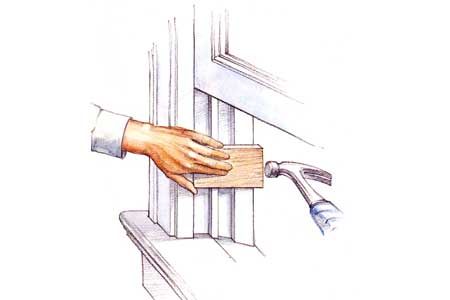Double-hung windows are a classic feature in many homes. But over time, they can get sticky or hard to open and close. A stubborn sash can be frustrating and might even pose a safety issue in emergencies. Fortunately, there’s a quick and simple fix to get your windows sliding smoothly again without major repairs or replacements.
Why Is the Sash Sticking?
Before beginning any repairs, identify the root cause of the sticking. Common issues are a buildup of paint, dirt, or minor warping of the wood. Over time, these can cause the sash to fit too tightly in its tracks, making it hard to move. Also check the window for worn-out weatherstripping or any broken parts, as these can affect how well your window operates.
Widening the channels where the sash slides is often the best solution for a stubborn sash. Two key components, the vertical stop molding and the parting bead, form these channels. The vertical stop molding holds the sash in place, and the parting bead sits between the two sashes. Adjusting these parts will help the sash move more smoothly.
Preparing for the Fix
You’ll need a few basic tools for this repair:
- Hammer
- Putty knife (optional)
- Safety goggles
- Utility knife
- Wood block
Make sure you’re working in a well-ventilated area and wear your safety goggles to protect your eyes from any debris.
Step-by-Step: Fast Fix for Widening the Channels
Follow these steps to widen the channels and fix a sticky sash:
- Raise or lower both sashes to access the problem area.
- If the stops are thickly coated with paint, use a utility knife to score the joints where they meet the side jambs. This helps prevent paint from chipping when you make adjustments.
- Hold a wood block against one of the stops.
- Give the wood block a few solid taps with a hammer. This should move the stop slightly, creating a wider channel.
- Try moving the sash up and down to test the improvement.
- If the sash moves a little easier but is still tight, repeat the procedure on the opposite stop.
We recommend testing the window after each adjustment to avoid widening the channels too much.
Fine-Tuning the Adjustment
Sometimes, the initial adjustment may not be enough. If that’s the case, you can make further refinements:
- Use a putty knife to gently pry the stop away from the jamb slightly.
- Test the sash movement again.
- If needed, gently tap the stop back into place. The aim is to leave it just a bit farther out than it originally was.
Remember, the goal is to create enough space for the sash to move freely while still allowing the window to seal properly when it’s closed. You might need to fine-tune the adjustment a few times to get it just right.
Additional Troubleshooting Tips
While widening the channels is often effective, there are other steps you can take to improve your window’s functionality beyond just addressing a tight fit.
Cleaning and Lubricating
Sometimes dirt and debris in the tracks causes a sticky sash. A good cleaning can often solve the problem:
- Vacuum the tracks to remove loose debris.
- Use a damp cloth to wipe down the tracks and remove any stubborn grime.
- Apply a silicone-based lubricant to the tracks and moving parts.
Avoid oil-based lubricants. They can attract dust and make the problem worse over time.
Addressing Paint Issues
Excess paint on window components can also cause sticking. If this is the case:
- Use a paint scraper or putty knife to remove excess paint from the tracks and moving parts carefully.
- Sand any rough areas smooth.
- Apply a thin coat of paint to exposed wood to prevent moisture damage.
Checking for Warping
In some cases, wood components may warp due to moisture or age. If you notice significant warping:
- Assess whether the affected parts can be adjusted or if they need replacement.
- Consult a professional if the warping is severe or if you’re unsure about making repairs. In some cases, parts may need to be replaced to restore function.

